belt KIA Borrego 2010 1.G Owner's Manual
[x] Cancel search | Manufacturer: KIA, Model Year: 2010, Model line: Borrego, Model: KIA Borrego 2010 1.GPages: 461, PDF Size: 12.25 MB
Page 9 of 461
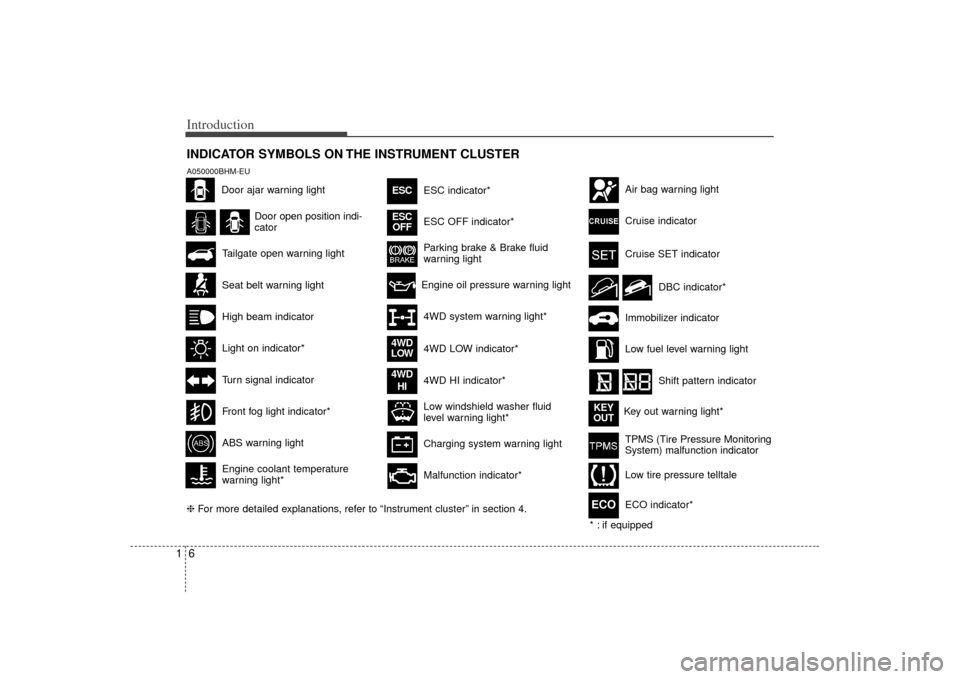
Introduction61INDICATOR SYMBOLS ON THE INSTRUMENT CLUSTER
Seat belt warning light
Door open position indi-
cator
Tailgate open warning lightHigh beam indicatorLight on indicator*Turn signal indicatorFront fog light indicator*ABS warning light
Parking brake & Brake fluid
warning lightEngine oil pressure warning light4WD system warning light*
4WD LOW indicator*
4WD HI indicator*Malfunction indicator*
Air bag warning lightCruise SET indicatorImmobilizer indicatorLow fuel level warning light
Shift pattern indicatorDBC indicator*
❈ For more detailed explanations, refer to “Instrument cluster” in section 4.
Charging system warning lightLow windshield washer fluid
level warning light*
Engine coolant temperature
warning light* ESC indicator*
A050000BHM-EU
Door ajar warning light
Key out warning light*
KEY
OUT
4WD
LOW4WD
HI
* : if equipped
Cruise indicator
ESC OFF indicator*
ESCESC
OFF
TPMS (Tire Pressure Monitoring
System) malfunction indicator Low tire pressure telltale
ECO indicator*
ECO
Page 14 of 461
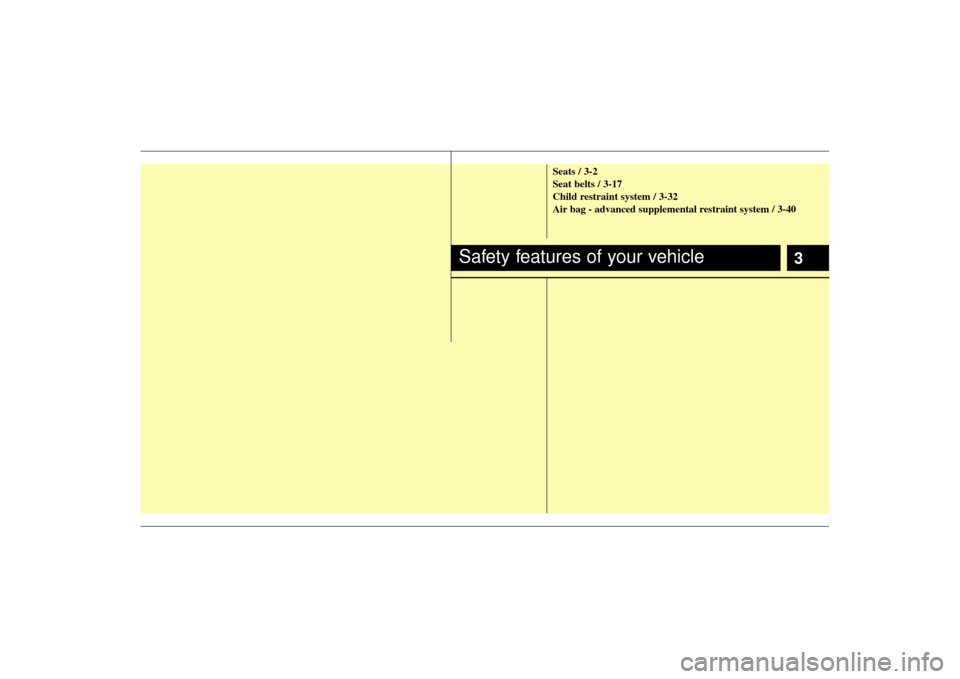
3
Seats / 3-2
Seat belts / 3-17
Child restraint system / 3-32
Air bag - advanced supplemental restraint system / 3-40
Safety features of your vehicle
Page 16 of 461
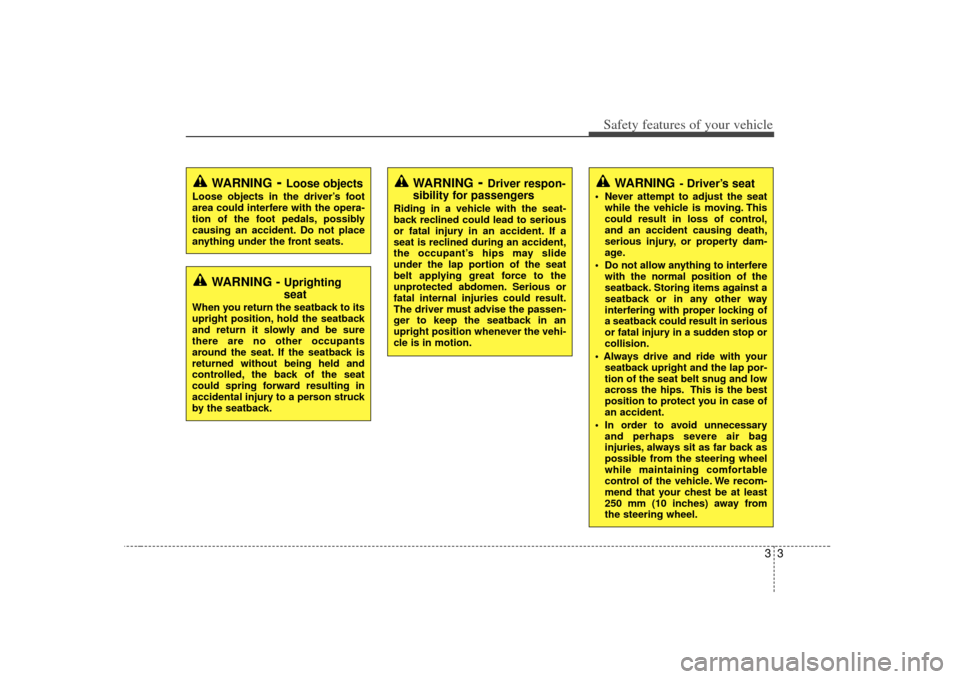
33
Safety features of your vehicleWARNING
- Driver’s seat
Never attempt to adjust the seatwhile the vehicle is moving. This
could result in loss of control,
and an accident causing death,
serious injury, or property dam-
age.
Do not allow anything to interfere with the normal position of the
seatback. Storing items against a
seatback or in any other way
interfering with proper locking of
a seatback could result in serious
or fatal injury in a sudden stop or
collision.
seatback upright and the lap por-
tion of the seat belt snug and low
across the hips. This is the best
position to protect you in case of
an accident.
In order to avoid unnecessary and perhaps severe air bag
injuries, always sit as far back as
possible from the steering wheel
while maintaining comfortable
control of the vehicle. We recom-
mend that your chest be at least
250 mm (10 inches) away from
the steering wheel.
WARNING -
Uprighting
seat
When you return the seatback to its
upright position, hold the seatback
and return it slowly and be sure
there are no other occupants
around the seat. If the seatback is
returned without being held and
controlled, the back of the seat
could spring forward resulting in
accidental injury to a person struck
by the seatback.
WARNING
- Loose objects
Loose objects in the driver’s foot
area could interfere with the opera-
tion of the foot pedals, possibly
causing an accident. Do not place
anything under the front seats.
WARNING
- Driver respon-
sibility for passengers
Riding in a vehicle with the seat-
back reclined could lead to serious
or fatal injury in an accident. If a
seat is reclined during an accident,
the occupant’s hips may slide
under the lap portion of the seat
belt applying great force to the
unprotected abdomen. Serious or
fatal internal injuries could result.
The driver must advise the passen-
ger to keep the seatback in an
upright position whenever the vehi-
cle is in motion.
Page 29 of 461
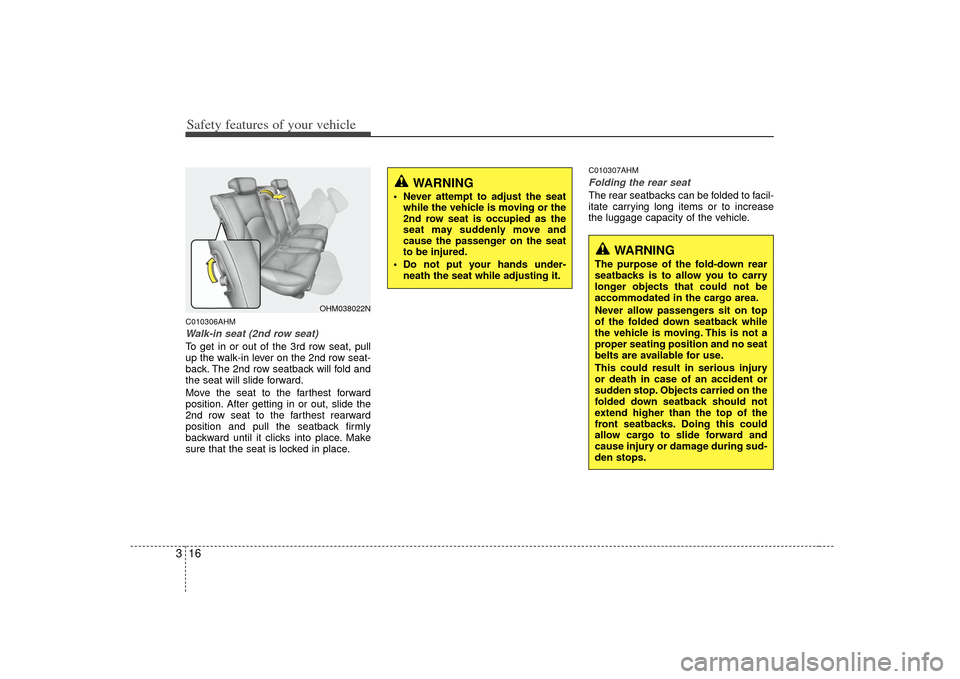
Safety features of your vehicle16
3C010306AHMWalk-in seat (2nd row seat)To get in or out of the 3rd row seat, pull
up the walk-in lever on the 2nd row seat-
back. The 2nd row seatback will fold and
the seat will slide forward.
Move the seat to the farthest forward
position. After getting in or out, slide the
2nd row seat to the farthest rearward
position and pull the seatback firmly
backward until it clicks into place. Make
sure that the seat is locked in place.
C010307AHMFolding the rear seatThe rear seatbacks can be folded to facil-
itate carrying long items or to increase
the luggage capacity of the vehicle.
OHM038022N
WARNING
The purpose of the fold-down rear
seatbacks is to allow you to carry
longer objects that could not be
accommodated in the cargo area.
Never allow passengers sit on top
of the folded down seatback while
the vehicle is moving. This is not a
proper seating position and no seat
belts are available for use.
This could result in serious injury
or death in case of an accident or
sudden stop. Objects carried on the
folded down seatback should not
extend higher than the top of the
front seatbacks. Doing this could
allow cargo to slide forward and
cause injury or damage during sud-
den stops.
WARNING
Never attempt to adjust the seat
while the vehicle is moving or the
2nd row seat is occupied as the
seat may suddenly move and
cause the passenger on the seat
to be injured.
Do not put your hands under- neath the seat while adjusting it.
Page 30 of 461
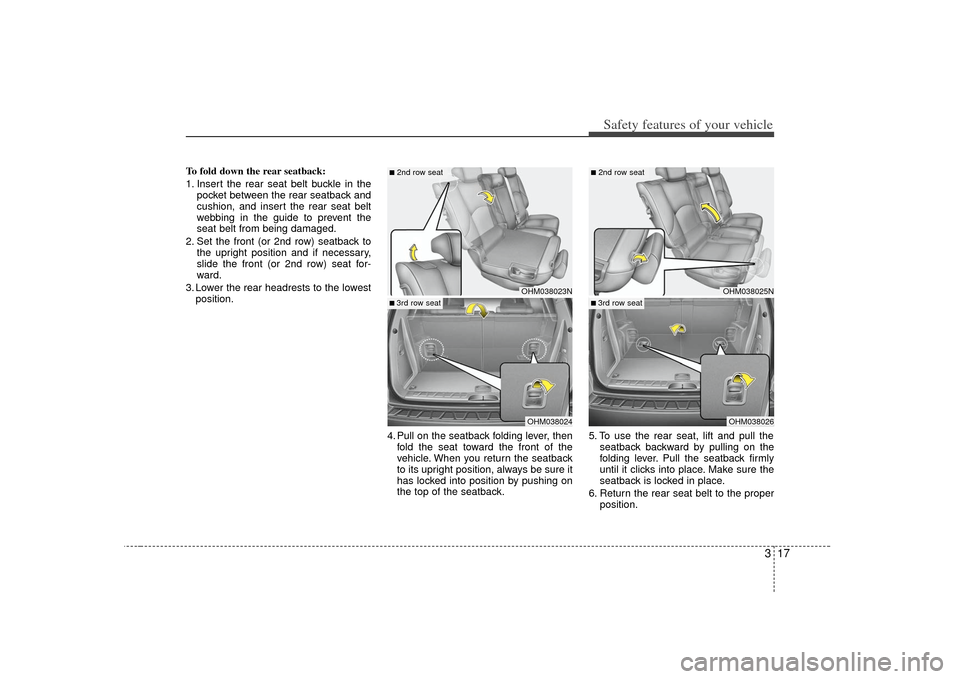
317
Safety features of your vehicle
To fold down the rear seatback:
1. Insert the rear seat belt buckle in thepocket between the rear seatback and
cushion, and insert the rear seat belt
webbing in the guide to prevent the
seat belt from being damaged.
2. Set the front (or 2nd row) seatback to the upright position and if necessary,
slide the front (or 2nd row) seat for-
ward.
3. Lower the rear headrests to the lowest position.
4. Pull on the seatback folding lever, thenfold the seat toward the front of the
vehicle. When you return the seatback
to its upright position, always be sure it
has locked into position by pushing on
the top of the seatback. 5. To use the rear seat, lift and pull the
seatback backward by pulling on the
folding lever. Pull the seatback firmly
until it clicks into place. Make sure the
seatback is locked in place.
6. Return the rear seat belt to the proper position.
OHM038023NOHM038024
■2nd row seat■ 3rd row seat
OHM038025NOHM038026
■2nd row seat■ 3rd row seat
Page 31 of 461
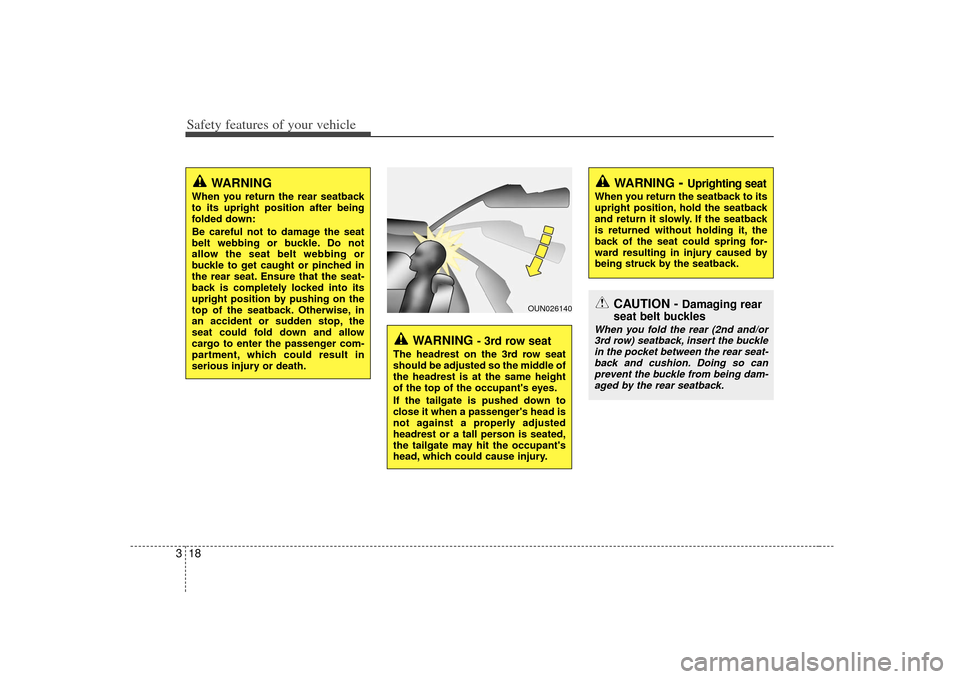
Safety features of your vehicle18
3
WARNING
When you return the rear seatback
to its upright position after being
folded down:
Be careful not to damage the seat
belt webbing or buckle. Do not
allow the seat belt webbing or
buckle to get caught or pinched in
the rear seat. Ensure that the seat-
back is completely locked into its
upright position by pushing on the
top of the seatback. Otherwise, in
an accident or sudden stop, the
seat could fold down and allow
cargo to enter the passenger com-
partment, which could result in
serious injury or death.
CAUTION -
Damaging rear
seat belt buckles
When you fold the rear (2nd and/or
3rd row) seatback, insert the buckle in the pocket between the rear seat-back and cushion. Doing so can prevent the buckle from being dam-aged by the rear seatback.
WARNING
- Uprighting seat
When you return the seatback to its
upright position, hold the seatback
and return it slowly. If the seatback
is returned without holding it, the
back of the seat could spring for-
ward resulting in injury caused by
being struck by the seatback.
OUN026140
WARNING
- 3rd row seat
The headrest on the 3rd row seat
should be adjusted so the middle of
the headrest is at the same height
of the top of the occupant's eyes.
If the tailgate is pushed down to
close it when a passenger's head is
not against a properly adjusted
headrest or a tall person is seated,
the tailgate may hit the occupant's
head, which could cause injury.
Page 32 of 461
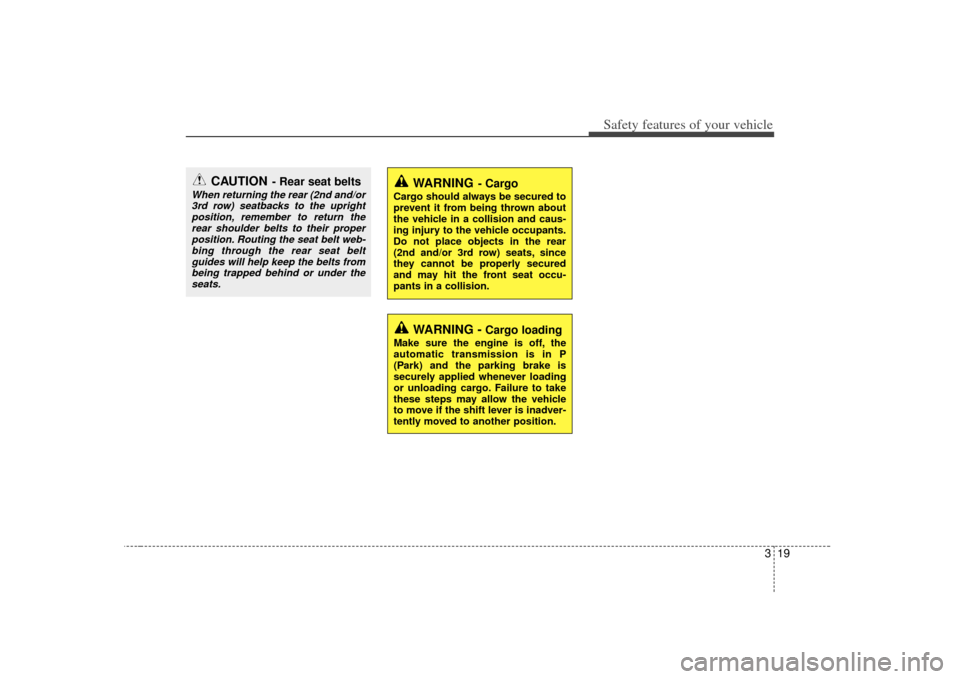
319
Safety features of your vehicle
WARNING -
Cargo loading
Make sure the engine is off, the
automatic transmission is in P
(Park) and the parking brake is
securely applied whenever loading
or unloading cargo. Failure to take
these steps may allow the vehicle
to move if the shift lever is inadver-
tently moved to another position.
WARNING
- Cargo
Cargo should always be secured to
prevent it from being thrown about
the vehicle in a collision and caus-
ing injury to the vehicle occupants.
Do not place objects in the rear
(2nd and/or 3rd row) seats, since
they cannot be properly secured
and may hit the front seat occu-
pants in a collision.
CAUTION
- Rear seat belts
When returning the rear (2nd and/or3rd row) seatbacks to the upright position, remember to return therear shoulder belts to their proper position. Routing the seat belt web-bing through the rear seat beltguides will help keep the belts frombeing trapped behind or under the seats.
Page 33 of 461
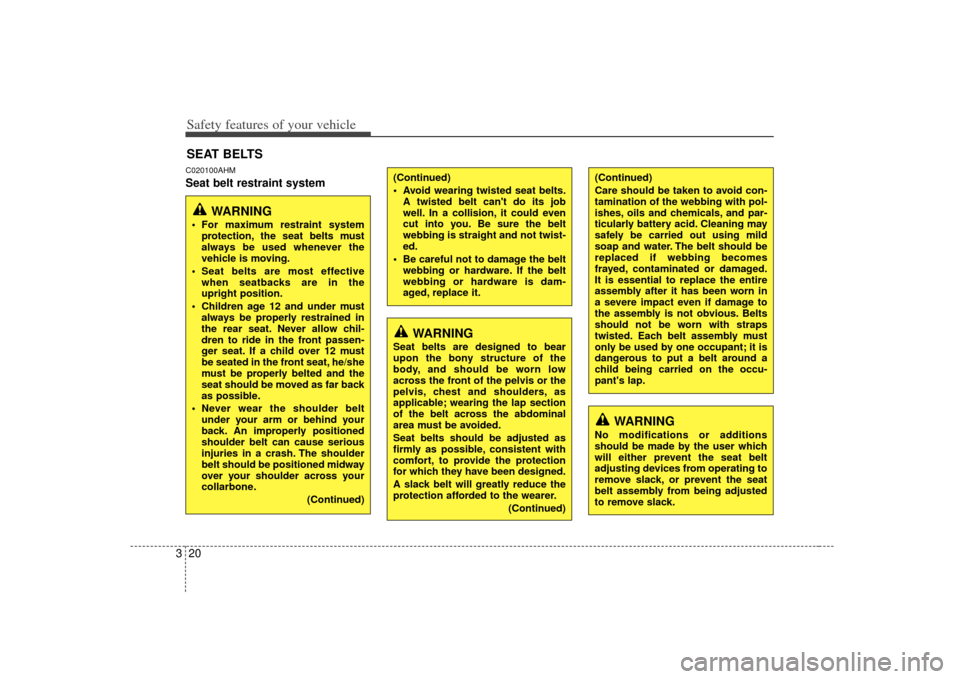
Safety features of your vehicle20
3C020100AHMSeat belt restraint systemSEAT BELTS
WARNING
For maximum restraint system
protection, the seat belts must
always be used whenever the
vehicle is moving.
Seat belts are most effective when seatbacks are in the
upright position.
Children age 12 and under must always be properly restrained in
the rear seat. Never allow chil-
dren to ride in the front passen-
ger seat. If a child over 12 must
be seated in the front seat, he/she
must be properly belted and the
seat should be moved as far back
as possible.
Never wear the shoulder belt under your arm or behind your
back. An improperly positioned
shoulder belt can cause serious
injuries in a crash. The shoulder
belt should be positioned midway
over your shoulder across your
collarbone.
(Continued)
WARNING
Seat belts are designed to bear
upon the bony structure of the
body, and should be worn low
across the front of the pelvis or the
pelvis, chest and shoulders, as
applicable; wearing the lap section
of the belt across the abdominal
area must be avoided.
Seat belts should be adjusted as
firmly as possible, consistent with
comfort, to provide the protection
for which they have been designed.
A slack belt will greatly reduce the
protection afforded to the wearer. (Continued)
(Continued)
Care should be taken to avoid con-
tamination of the webbing with pol-
ishes, oils and chemicals, and par-
ticularly battery acid. Cleaning may
safely be carried out using mild
soap and water. The belt should be
replaced if webbing becomes
frayed, contaminated or damaged.
It is essential to replace the entire
assembly after it has been worn in
a severe impact even if damage to
the assembly is not obvious. Belts
should not be worn with straps
twisted. Each belt assembly must
only be used by one occupant; it is
dangerous to put a belt around a
child being carried on the occu-
pant's lap.
WARNING
No modifications or additions
should be made by the user which
will either prevent the seat belt
adjusting devices from operating to
remove slack, or prevent the seat
belt assembly from being adjusted
to remove slack.
(Continued)
Avoid wearing twisted seat belts.A twisted belt can't do its job
well. In a collision, it could even
cut into you. Be sure the belt
webbing is straight and not twist-
ed.
Be careful not to damage the belt webbing or hardware. If the belt
webbing or hardware is dam-
aged, replace it.
Page 34 of 461
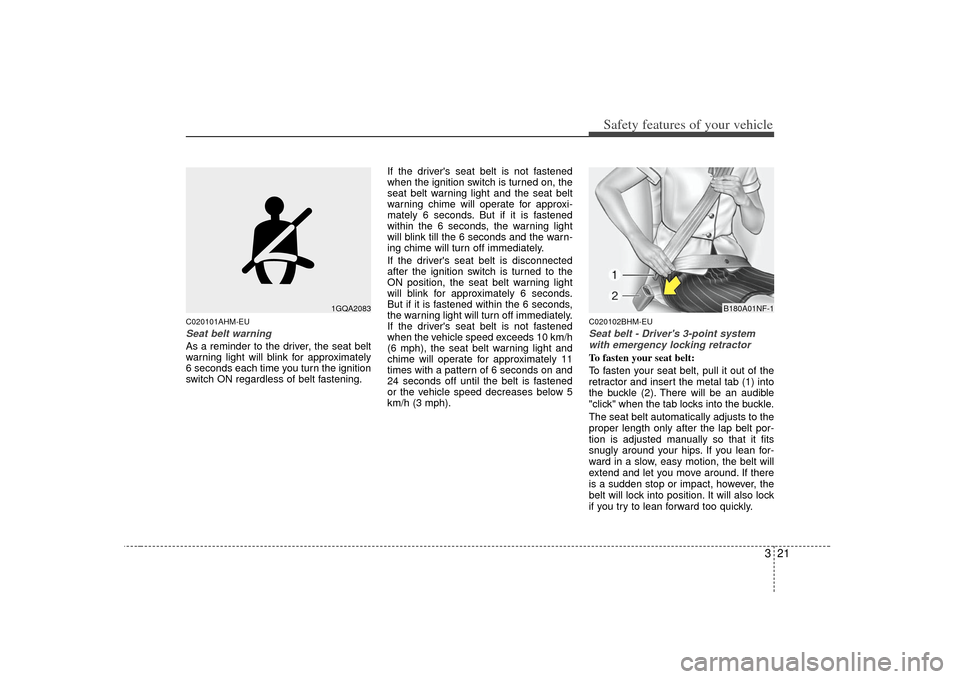
321
Safety features of your vehicle
C020101AHM-EUSeat belt warningAs a reminder to the driver, the seat belt
warning light will blink for approximately
6 seconds each time you turn the ignition
switch ON regardless of belt fastening.If the driver's seat belt is not fastened
when the ignition switch is turned on, the
seat belt warning light and the seat belt
warning chime will operate for approxi-
mately 6 seconds. But if it is fastened
within the 6 seconds, the warning light
will blink till the 6 seconds and the warn-
ing chime will turn off immediately.
If the driver's seat belt is disconnected
after the ignition switch is turned to the
ON position, the seat belt warning light
will blink for approximately 6 seconds.
But if it is fastened within the 6 seconds,
the warning light will turn off immediately.
If the driver's seat belt is not fastened
when the vehicle speed exceeds 10 km/h
(6 mph), the seat belt warning light and
chime will operate for approximately 11
times with a pattern of 6 seconds on and
24 seconds off until the belt is fastened
or the vehicle speed decreases below 5
km/h (3 mph).
C020102BHM-EUSeat belt - Driver's 3-point system
with emergency locking retractorTo fasten your seat belt:
To fasten your seat belt, pull it out of the
retractor and insert the metal tab (1) into
the buckle (2). There will be an audible
"click" when the tab locks into the buckle.
The seat belt automatically adjusts to the
proper length only after the lap belt por-
tion is adjusted manually so that it fits
snugly around your hips. If you lean for-
ward in a slow, easy motion, the belt will
extend and let you move around. If there
is a sudden stop or impact, however, the
belt will lock into position. It will also lock
if you try to lean forward too quickly.
1GQA2083
B180A01NF-1
Page 35 of 461
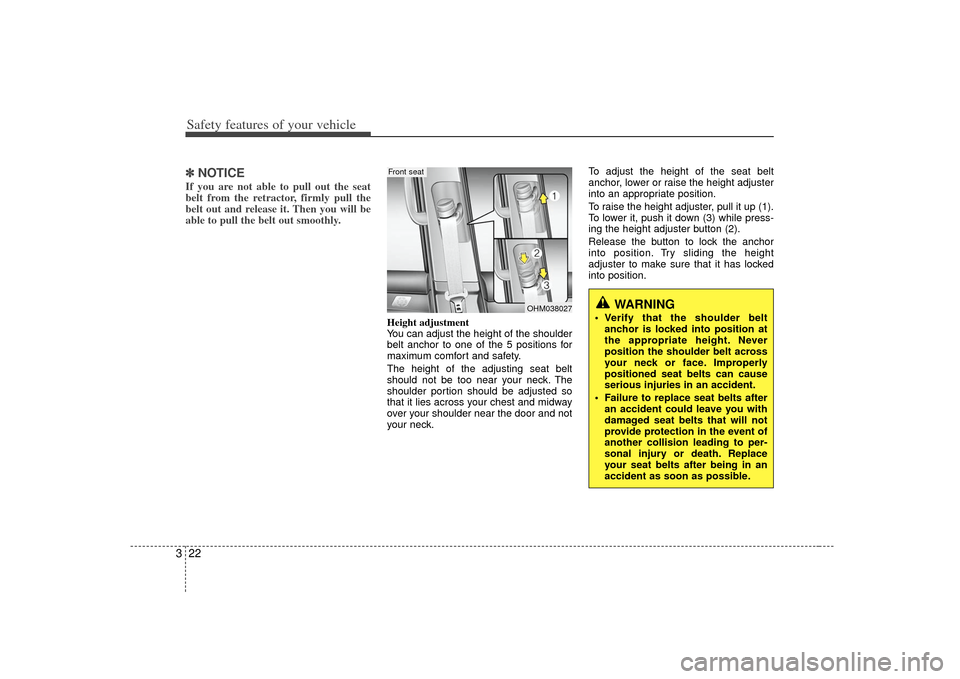
Safety features of your vehicle22
3✽
✽
NOTICEIf you are not able to pull out the seat
belt from the retractor, firmly pull the
belt out and release it. Then you will be
able to pull the belt out smoothly.
Height adjustment
You can adjust the height of the shoulder
belt anchor to one of the 5 positions for
maximum comfort and safety.
The height of the adjusting seat belt
should not be too near your neck. The
shoulder portion should be adjusted so
that it lies across your chest and midway
over your shoulder near the door and not
your neck. To adjust the height of the seat belt
anchor, lower or raise the height adjuster
into an appropriate position.
To raise the height adjuster, pull it up (1).
To lower it, push it down (3) while press-
ing the height adjuster button (2).
Release the button to lock the anchor
into position. Try sliding the height
adjuster to make sure that it has locked
into position.
OHM038027
Front seat
WARNING
Verify that the shoulder belt
anchor is locked into position at
the appropriate height. Never
position the shoulder belt across
your neck or face. Improperly
positioned seat belts can cause
serious injuries in an accident.
Failure to replace seat belts after an accident could leave you with
damaged seat belts that will not
provide protection in the event of
another collision leading to per-
sonal injury or death. Replace
your seat belts after being in an
accident as soon as possible.